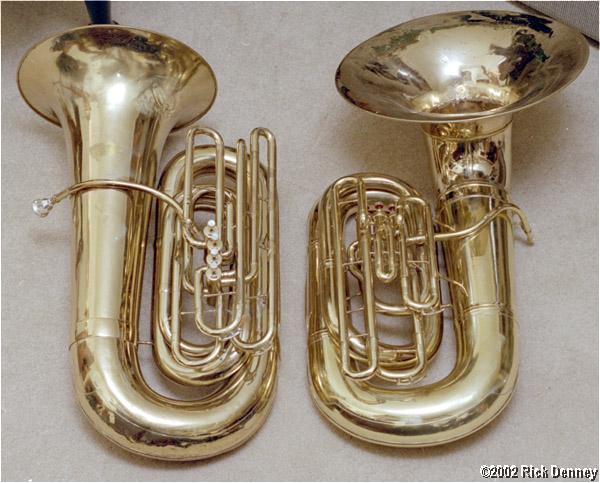Shockwave wrote: I dont have that many different size tubas here, so would anyone care to test the hypothesis?
-Eric
All models are false, but some are useful. Your model assumes that bells flare the same way on all tubas, and they don't, not even down at the 20-degree angle.
But, in reality, I find little correlation between any single measure and any given quality of sound, beyond extremely broad generalizations that aren't of much use.
Some history, for those who have not yet heard the tune:
It was probably Rudolf Meinl that made popular the quarter system. RM designated their tubas based on bell size: 6/4 had a 22" bell, 5/4 had a 20" bell, 4/4 had an 18" bell, and 3/4 had a 16" bell (given or take an inch in all cases). Of course, bell diameter has zero relevance outside their line, because there are lots of smallish tubas with big bells, and quite a few really big tubas with small bells. But Rudi Meinl made all their tubas proportional, so that the fatness of the tuba was directly proportional to the bell size.
It was also probably true that no 6/4 instrument made it to these shores, or to the American consciousness, before the 70's or so. At that time, there were regular tubas (Miraphone 186, 188, Alex 163, and so on) and kaiser tubas (Miraphone 190, Alex 164, etc.). These were called 4/4 and 5/4, according to European custom.
The CSO York and other very large American-style tubas were a special case, and were not measured in those terms. Originally, they were called Monster instruments. The York, for example, in BBb form, was the Monster BBb Bass. Conn called theirs an Orchestra Grand Bass (the 36J). They also used the word "Jumbo" to describe the equivalently oversized sousaphones (named, in case you were curious, after the elephant P. T. Barnum bought from the British circus in the 1850's--the word did not exist before that time).
Most of the European manufacturers (at least those on the Continent) named their standard instrument a 4/4 and their kaiser a 5/4. You still see this designation with that most traditional of companies that still exists, Cerveny. Their 601, which is really as big as most BAT's, is called by them a 5/4.
But then Hirsbrunner copied the CSO York. Custom Music Company sold the instrument in the U.S., and I suspect they desired to describe the fatness of that instrument using a term that would command attention. I think the Yorkbrunner was the first tuba to be advertised in the U.S. as a 6/4 instrument.
Hirsbrunner's own designation is "grand orchestral tuba", which to me is a more accurate name for an American-style ultra-fat tuba than "6/4", and it has the provenance of Conn's usage without the unsophistication of "monster". It's a little ironic that the Swiss company adopted the name with the American provenance, while their American importer used a European designation. But, with the exception of those few using Holtons (the only viable alternative to the York in those days), the standard instruments in American orchestras were the German type. That was the target market for the new Yorkbrunner, and they may have wanted to distinguish the Yorkbrunner from regular tubas in those terms.
In any case, the designation stuck. Now, any tuba of the ultra-fat American Yorkish design is called a 6/4, while most German kaiser tubas (except the Rudi Meinl 6/4, which requires three native bearers and a special trailer) are called "5/4", even when they are really just as big. Now, slightly downsized versions of the Yorkophones, such as the Meinl-Weston 2155 and 2000, the PT-6 (which is a little big for the category), the Hirsbrunner HB-21, and so on, are called "5/4", mostly to distinguish them from standard tubas like the Miraphone 186, which is a 4/4.
"BAT" encompasses probably more instruments that would have originally been called "6/4", mostly because the instruments being referred to predate such foolishness. The Conn 2xJ is an example. My 20J was every bit as big as the Holton, but it has a smaller throat than the Holton (see pic).

As to the popular use of "BAT", it comes from usage on either TubeNet or TubaEuph. I first remember seeing it when Tony Clements described his taxonomy of tubas, which ranged from 3/4 (Is that a euphonium?) to 6/4 (Big-*** Tuba).
Rick "thinking the instruments define the words, not the other way around" Denney




